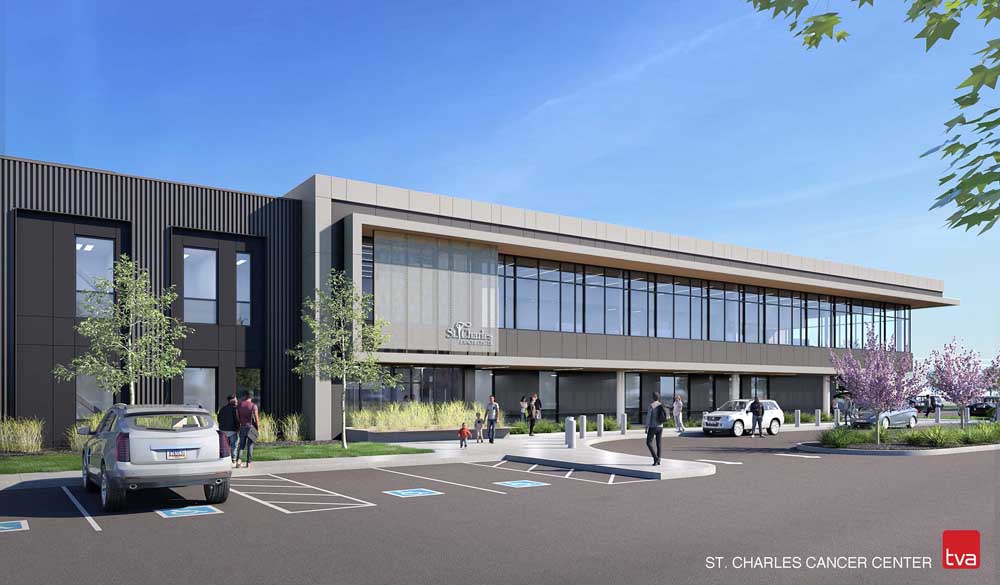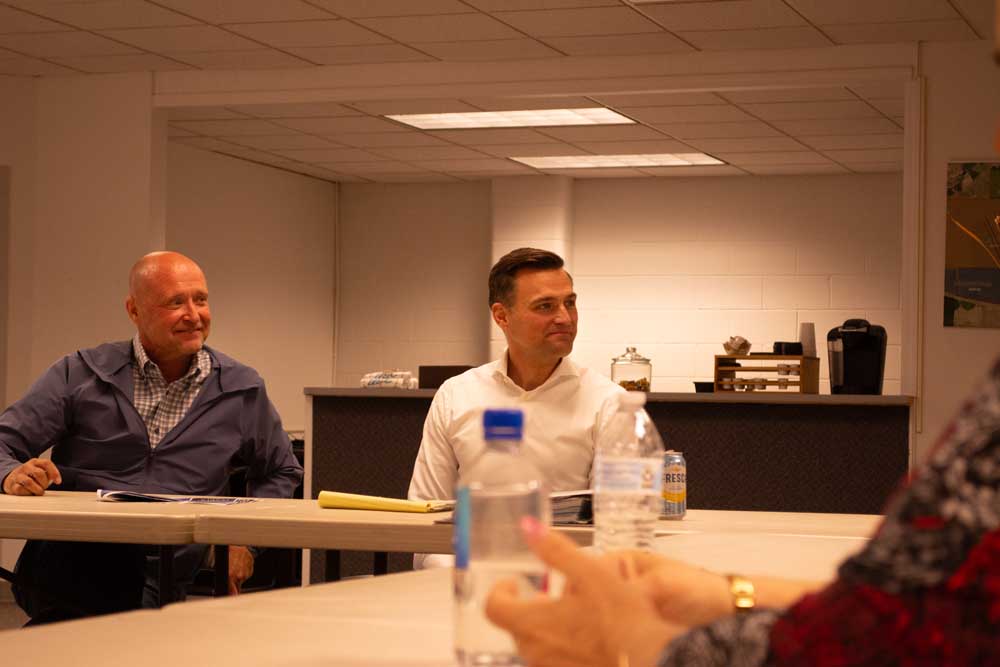Deschutes County’s population growth strains health care
Published 5:00 am Saturday, August 24, 2024

- Artist rendering of what the St. Charles Health System Redmond Cancer Center may look like.
Over the past quarter of a century, the population in Deschutes County has doubled in size, but the number of health care professionals has not kept pace.
Deschutes County has more than 200,000 people, about double what it had in 2000.
Trending
Each of these people at some time will need medical attention or take a trip to the doctor. With health care providers consolidating, rising costs and a national nursing and physician shortage, the wait can be weeks.
Despite a growing job market in the field of health care, there is a national nursing and physician shortage affecting Central Oregon, medical staff burnout is at an all time high and the over 60 population is aging and will need more care.
“We have a health care workforce shortage in medicine, just like in nursing,” said Dr. Mark Hallett, St. Charles Health System chief clinical officer. “At the same time, we have access needs in Central and Eastern Oregon in an area with a growing population. And while stable in some specialties, a declining workforce in others. We need to be as efficient and productive as possible.”
Central Oregon lacks bed capacity for children in mental health crisis
Trending
If staff shortages are not enough to put pressure on the medical system, costs for consumers keep rising. Consumers spent 3.6% more on health care between 2021-2022, according to the Oregon Health Authority. Health care costs have risen so much in Oregon that 23% of a household’s income is spent on health care, more than housing, transportation and food, according to the health authority report.
Despite this, health care systems are not harvesting a bumper crop of profits, either. The same report states that health insurance costs have doubled since 2000, but income has lagged.
“The needs and expectations of the patients have continued to rise,” Hallett said. “Frankly, so have our aspirations to deliver safe and timely and effective and equitable, high quality care. We put a lot of expectations on ourselves.”
If a grade was given, the health care industry would earn a C-minus, depending on the medical specialty, said Dr. Sarah Dawson, a Bend internal medicine physician who opened her own direct primary care practice.
Unparalleled access: Patients pay monthly fee for doctor who delivers unfettered care
“Some specialties are worse than others,” Dawson said. “The population has outpaced physician recruitment.”
The revenue challenge in Central Oregon
In 2000, there were just two St. Charles hospitals, in Bend and Redmond. Today the health system has four hospitals, adding hospitals in Prineville and Madras.
St. Charles Health System, the only hospital system in Central Oregon and the region’s largest employer, reported more than $1 billion in revenues in 2023, an increase over the previous year. But the increases came after two years of declining revenues and increased costs, cuts to staff and higher wages paid to nursing staff to retain and recruit.
Meeting the needs of the community is an ever-evolving process, Hallett said.
In 2019, the health system closed the Redmond birthing center citing less than half capacity being used in Bend and Redmond. But earlier this year, the health system broke ground on a $90 million cancer center to treat patients coming from Prineville, Madras and beyond for treatment.
Changes in the health care landscape aren’t confined to Bend and Redmond. In south Deschutes County, growth is also occurring. The La Pine Community Health Center is in the midst of completing a $16 million expansion project designed to meet the growing needs of the region. For years residents in La Pine drove the 40 minutes to Bend to receive some dental treatments, mammograms and behavioral health services.
La Pine Community Health Center grows to meet the community needs
Also compounding the financial picture are the pre-established payments coming from Medicare and Medicaid. At St. Charles, about 57% of the patients paid their bills through Medicare in 2022, compared to 55.9% in 2020, according to health system’s annual report. That affects the bottom line.
Private insurers pay nearly double Medicare rates, according to a KFF Health News, formerly known as Kaiser Health News.
“At the end of the day, health care is a service,” said Kat Mastrangelo, Volunteers in Medicine executive director. “The biggest cost is always people and wages and those have certainly gone up. The doctors are not getting paid more, but the patient is paying more of what the costs are.”
Central Oregon workforce growth
Since 2001, the number of jobs in the health services and education job market in Central Oregon has grown the most of any other sector, said Nicole Ramos, Oregon Employment Department regional economist. In 2001, the health services and private education sector employed 6,780 people, compared to 17,680 people in 2023.
The Bulletin’s yearlong series is focused on the impacts and solutions related to growth in Central Oregon.
Read the full collection of stories.
That more than doubling of jobs in the health and education sectors, which mirrors the state’s job growth. Health care is the second largest employment sector in Central Oregon’s economy, behind trade, transportation and utilities, Ramos said.
While the job growth in Central Oregon benefits the economy, it will take creativity to overcome a national shortage of physicians and nurses, Hallett said.
Statewide, the hospital industry made up 23% of the state’s employment, employing nearly 300,000 people. The payroll in 2022 statewide in the hospital industry totaled $18.4 billion.
By 2032, the number of health care jobs is expected to continue to grow by as much as 15%, according to employment projections. But still that may not be enough.
Nationwide, there will be a projected shortage of 78,610 full time registered nurses by next year, according to the American Association of Colleges of Nursing data.
What’s causing St. Charles Bend staff shortages? Nurses, hospital system disagree
Making sure the city is prepared for this growth is important to policy makers. Because of Bend’s geographic isolation, sometimes it’s difficult to encourage medical specialists to relocate here, said Tierney O’Dea Booker, a member of the Bend Economic Development Advisory Board that works to provide business development advice to the Bend City Council.
“The city seems to be concerned,” said O’Dea Booker said. “If we leave it up to the market, we’ll have gaps in our health care in our town. Our city’s effort to incentivize specialists and doctors to relocate here will reduce our reliance on sending people across the mountain for care.”
That’s where the city’s policy interventions can come in, said Ben Hemson, Bend Economic Development manager. Health care is among the city’s top industries that it wants to cultivate and grow, Hemson said. The council is considering ways to attract businesses through tax incentives or waiving or reducing the cost of development fees.
Medical options around town
Mosaic Community Health center got its start in Prineville when a group of community members created a nonprofit organization to care for patients in the community. That first year, 700 individuals were seen by medical professionals. Today the community health center sees an average of 27,000 patients in Bend, Redmond, Madras, Sisters and Prineville and even schools, according to the health center’s website.
Mosaic Medical celebrates 20 years in Central Oregon
“As a non-profit community health center, we are dedicated to providing access to health care to everyone in our community,” said Megan Haase, Mosaic Community Health CEO. “Since our first clinic in Prineville in 2002, we now have 16 clinics throughout Central Oregon. Even as we continue to expand to meet the community needs we find that the demand for health care services outpaces access.”
Most of the patients are on Oregon Health Plan, Medicaid or Medicare, but the payer mix is not a limiting factor for growth. What limits growth, Haase said, are the workforce shortages. Conversations about the workforce are tied to the high cost of living in Central Oregon, namely high housing costs, she said.
In fact, Mosaic is at the drawing board for plans to expand its Bend clinic in the next couple of years, said Elaine Knobbs-Seasholtz, Mosaic Community health director of strategy and development.
“Our strategic planning and needs assessment research show us there is clearly a need for more health care facilities in our region,” Knobbs-Seasholtz said.
An aging population
Bend has the highest concentration of the Central Oregon population, which makes it easier to find care compared to more remote areas like Prineville and Madras. The over 60 population in Deschutes County, which accounts for 28.7% of the population now, is expected to grow to about a third of the population by 2047, according to data provided by the Central Oregon Council on Aging.
Older adults, who need more health care, often have access troubles. Daily the Council on Aging gets phone calls seeking help for transportation to get to medical appointments, said Cassie Regimbal, Central Oregon Council on Aging executive director. The council receives near daily phone calls from elderly residents seeking transportation to medical appointments, Regimbal said.
“It’s a big barrier to accessing care, particularly in La Pine. Dial-A-Ride is only available in the city limits, not from outside the city limits,” Regimbal said. “We don’t offer transportation. We have to refer to other options or service providers.”
Another issue, Regimbal said, is access to specialty care like behavioral health. For a senior citizen with physical limitations, accessing affordable in-home care can also be an issue, she said.
The population is only going to get older in Deschutes County, she said. The council’s services, which are supported by the federal Older Americans Act, will only be relied upon more as the population ages.
“If your basic needs are not met, it impacts your health,” Regimbal said. “Nutrition, social engagement, access to affordable medication, all of these tie into your overall health. Then you add housing and transportation, and our limited program is not meeting the needs. We have wait lists.”
Growth in Central Oregon: a yearlong series
The Bulletin’s yearlong series is focused on the impacts and solutions related to growth in Central Oregon.
We’re comparing how civic groups, government officials and local leaders addressed growth 20 to 25 years ago to today, with a focus on four areas — environment, infrastructure, economics and housing. Bulletin reporters will examine the success of previous solutions, current approaches to growth issues.








